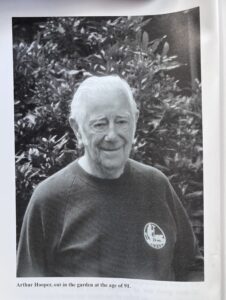
Arthur Hooper
Publisher: Malthouse Press
Let’s imagine a hierarchy … at the top sits Downton Abbey.
Downton Abbey: A series, set on the fictional Yorkshire country estate Downton Abbey between 1912 and 1926, depicts the lives of the aristocratic Crawley family and their domestic servants in the post Edwardian era, and the effects the great events of the time have on their lives and on the British Social Hierarchy (Wickepedia).
Under the “Abbey” we have Upstairs Downstairs: It chronicles the lives of the two sets of people living in a large London house – the aristocratic Bellamy family (upstairs) and their servants (downstairs) from 1903 to 1930. The undoubted head of the downstairs ensemble is Hudson the butler (Gordon Jackson) who is a bigger snob than any of the upstairs lot (Amazon).
At the bottom of the hierarchy we have “Life in the Gardeners’ Bothy” or as I’ve renamed it to appeal to a wider tv audience “Getting dirty in stately homes”.
Life in the gardeners’ bothy documents Arthur Hoopers journey from leaving school at 14 years old in the early 1920’s, up until his retirement, as Head Gardener, in 1975. The style of writing is rustic as befitting the subject matter. There is no “nod” to poetic expression, to romanticism, or to fanciful elaboration. Mr Hooper takes us through an honest, heartfelt, and literal diary of his life in the gardens of some of England’s great estates. We follow Arthur from 3rd, 2nd, and 1st journeyman, to foreman of various stately home areas, to general foreman and eventually up to Head gardener. As the son of a Head Gardener,  we are given insights into a tightly structured, tiered, almost feudal life. We experience Arthur’s journey from his adolescent immersion into the Bothy life, his time as a “Bothy boy”, across various stately homes, into adulthood, from glass houses to the Chelsea Flower Show, experiences of poachers and the pompous, through to his retirement.
we are given insights into a tightly structured, tiered, almost feudal life. We experience Arthur’s journey from his adolescent immersion into the Bothy life, his time as a “Bothy boy”, across various stately homes, into adulthood, from glass houses to the Chelsea Flower Show, experiences of poachers and the pompous, through to his retirement.
There are occasional glimpses of the Arthur’s emotional journey, and the fact that these glimpses are sporadic, gives them added power and impetus. It feels like an echo of a time when those of a certain class weren’t supposed to talk about their feelings. Indeed, it’s possible that, those of a certain class never acquired the skills to articulate the complex and illuminative world of “feelings”. “Hierarchy” is a thread that is writ large throughout the book. The etiquette of life within the Bothy (no women, the seating arrangements at the table, buying the weekly food, etc), relationships with the house staff (cooks, servants, and Head Butler), are all described in a matter-of-fact way that brings them to life.

This is a slow-paced, but thoroughly enjoyable read. Indeed, the sedate pace generates a nostalgic, relaxed and contemplative tone in harkening back to life in the 20’s and 30’s, up until the outbreak of WW2. We are connected to lives lived at what might seem to us to be a slow pace, indeed, it is that slowness that is so appealing about this read. It must be said that there were times when my working class roots kicked in and I felt a twinge of frustration and annoyance at the required deference and “doff your cap” mentality that those in these “lower” classes had to show … but that was the reality. I wondered if I would behave in the same way were I in that situation. I suspect I would.
Interestingly, the writing style mirrored that of my father-in-law when he chose to write his autobiography for his children and grandchildren.
Price: It’s out of print but still available from many outlets online for between £3 to £4 Bargain!
